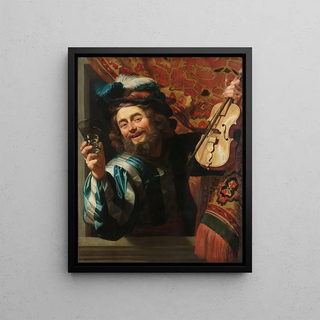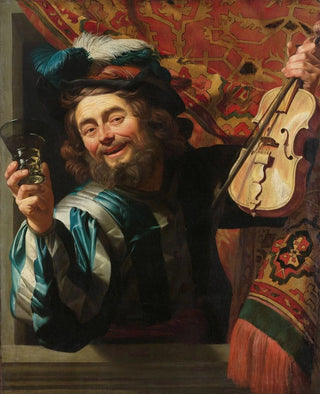Art print | The Joyful Violinist - Gerard van Honthorst


View from behind

Frame (optional)
In the fascinating world of Baroque art, "The Joyful Violinist" by Gerard van Honthorst stands out as an iconic artwork, capturing the very essence of joy and music. This canvas, created in the early 17th century, invites viewers to immerse themselves in a vibrant scene where light and shadow dance harmoniously. The eye is immediately drawn to the violinist, whose cheerful expression and dynamic posture suggest an engaging melody. Honthorst, master of light, uses contrasts to bring his characters to life, creating an almost palpable festive atmosphere. This painting does more than depict a moment; it captures its emotion, making each gaze a journey into the heart of music.
Style and uniqueness of the artwork
Gerard van Honthorst's style is characterized by a masterful use of chiaroscuro, a technique that highlights light plays to emphasize the features of the characters and the details of the scene. In "The Joyful Violinist," this approach is particularly successful. The light seems to emanate from the violinist himself, illuminating his face and hands, while shadows subtly envelop the background, creating a striking contrast. Rich, warm colors reinforce this impression of warmth and conviviality. Honthorst does not merely paint a musician; he conveys a sensory experience, making the strings of the violin resonate in the observer's mind. The composition, balanced and dynamic, guides the viewer through the scene, allowing appreciation of every detail, every expression, as if witnessing a musical performance live.
The artist and his influence
Gerard van Honthorst, a prominent figure of Dutch Baroque, managed to establish himself thanks to his unique talent for capturing the human soul through painting. Trained in Utrecht, he was influenced by masters such as Caravaggio, whose techniques he integrated while developing his own style. Honthorst notably adapted to the tastes of his time, creating works that reflect the pleasures of daily life and social celebrations. His impact on

Matte finish

View from behind

Frame (optional)
In the fascinating world of Baroque art, "The Joyful Violinist" by Gerard van Honthorst stands out as an iconic artwork, capturing the very essence of joy and music. This canvas, created in the early 17th century, invites viewers to immerse themselves in a vibrant scene where light and shadow dance harmoniously. The eye is immediately drawn to the violinist, whose cheerful expression and dynamic posture suggest an engaging melody. Honthorst, master of light, uses contrasts to bring his characters to life, creating an almost palpable festive atmosphere. This painting does more than depict a moment; it captures its emotion, making each gaze a journey into the heart of music.
Style and uniqueness of the artwork
Gerard van Honthorst's style is characterized by a masterful use of chiaroscuro, a technique that highlights light plays to emphasize the features of the characters and the details of the scene. In "The Joyful Violinist," this approach is particularly successful. The light seems to emanate from the violinist himself, illuminating his face and hands, while shadows subtly envelop the background, creating a striking contrast. Rich, warm colors reinforce this impression of warmth and conviviality. Honthorst does not merely paint a musician; he conveys a sensory experience, making the strings of the violin resonate in the observer's mind. The composition, balanced and dynamic, guides the viewer through the scene, allowing appreciation of every detail, every expression, as if witnessing a musical performance live.
The artist and his influence
Gerard van Honthorst, a prominent figure of Dutch Baroque, managed to establish himself thanks to his unique talent for capturing the human soul through painting. Trained in Utrecht, he was influenced by masters such as Caravaggio, whose techniques he integrated while developing his own style. Honthorst notably adapted to the tastes of his time, creating works that reflect the pleasures of daily life and social celebrations. His impact on






